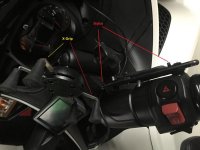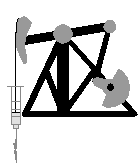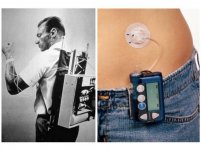OverHillAndDale
Member
Nearly 20 years I slowly became aware I was being honked at, I’m still not sure precisely for what. :shocked: My Honda was way in the red line and I was in first gear. I didn’t know where I was or how I got there, and it slowly dawned on me I was in a serious insulin reaction. Fortunately, no harm was done other than to my self-confidence and to some other driver’s nerves.
Technology has improved a lot since then, but not utilizing the tools we have to prevent that sort of circumstance is inexcusable. Although a sensor may alert you to highs and lows, you can’t hear the alerts when ryding, and when the pump vibrates you may not be able to feel it. And, you certainly may not be able to tell if it is an alert worth pulling off the road and checking. In winter ryding gear, it might be too late before you notice and respond to a potential event. Stopping every few miles and performing a finger stick is not viable, particularly wearing gloves and riding gear. However, I’ve finally assembled a set of components and settings that I believe has greatly reduced the probability of this ever happening again. (I’d like to say “virtually eliminated”, but I don’t want to tempt fate…)
I wear a MiniMed pump and use the EnLite sensors. I recently purchased the Uploader, which transmits the pump’s blood sugar readings to my cell phone (unfortunately, it only works with iPhones at the moment but I’m sure that will change soon). I know there are other brands of sensors that will also work, but using this combination allows me to monitor my active insulin.
I have my phone mounted in a RAM X-Grip on the right handlebar (see pic - it's dark but clear). To make this work, I also have a USB connector on my dash. If the iPhone is charging AND is left playing music (I keep iTunes playing in the background software), the screen won’t lock. I also purchased a small stylus, so I can tap the screen even when I’m wearing full fingered gloves. I have it mounted with just a small amount of Velcro where I can easily retrieve it in gloves to tap the screen if I need to (just above emergency flasher on ride side, see pic).

When I first start the motor, I set iTunes playing at a low volume and open the MiniMed screen. With the phone mounted vertically, the MiniMed screen will display
When the screen dims out, a touch with my finger (or with the stylus I have velcroed in place) will make it bright again.
This is not a distraction as it is not necessary to glance at the phone more than every 5 minutes or so, as that is as often as it refreshes. So far, this has kept me apprised not only of eminent danger, but keeps me watching trends so I know when to relax, when to pull off and bolus, when to open the bottle of sweet soda I keep handy. More than once I’ve caught my BS sliding downwards when I didn’t expect it, or heading up enough I decided to pull off, test of blood sugar with a meter and bolus accordingly.
I'd love to hear what others do to keep their blood sugar at a safe level while ryding.
Technology has improved a lot since then, but not utilizing the tools we have to prevent that sort of circumstance is inexcusable. Although a sensor may alert you to highs and lows, you can’t hear the alerts when ryding, and when the pump vibrates you may not be able to feel it. And, you certainly may not be able to tell if it is an alert worth pulling off the road and checking. In winter ryding gear, it might be too late before you notice and respond to a potential event. Stopping every few miles and performing a finger stick is not viable, particularly wearing gloves and riding gear. However, I’ve finally assembled a set of components and settings that I believe has greatly reduced the probability of this ever happening again. (I’d like to say “virtually eliminated”, but I don’t want to tempt fate…)
I wear a MiniMed pump and use the EnLite sensors. I recently purchased the Uploader, which transmits the pump’s blood sugar readings to my cell phone (unfortunately, it only works with iPhones at the moment but I’m sure that will change soon). I know there are other brands of sensors that will also work, but using this combination allows me to monitor my active insulin.
I have my phone mounted in a RAM X-Grip on the right handlebar (see pic - it's dark but clear). To make this work, I also have a USB connector on my dash. If the iPhone is charging AND is left playing music (I keep iTunes playing in the background software), the screen won’t lock. I also purchased a small stylus, so I can tap the screen even when I’m wearing full fingered gloves. I have it mounted with just a small amount of Velcro where I can easily retrieve it in gloves to tap the screen if I need to (just above emergency flasher on ride side, see pic).
When I first start the motor, I set iTunes playing at a low volume and open the MiniMed screen. With the phone mounted vertically, the MiniMed screen will display
- my current blood sugar reading,
- the relative speed at which my blood sugar is changing, and
- the amount of active insulin.
When the screen dims out, a touch with my finger (or with the stylus I have velcroed in place) will make it bright again.
This is not a distraction as it is not necessary to glance at the phone more than every 5 minutes or so, as that is as often as it refreshes. So far, this has kept me apprised not only of eminent danger, but keeps me watching trends so I know when to relax, when to pull off and bolus, when to open the bottle of sweet soda I keep handy. More than once I’ve caught my BS sliding downwards when I didn’t expect it, or heading up enough I decided to pull off, test of blood sugar with a meter and bolus accordingly.
I'd love to hear what others do to keep their blood sugar at a safe level while ryding.




